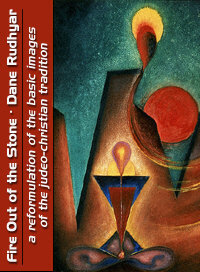 |
| Home | Bio | Art | Music | Literature | Civilization & Culture | Philosophy of Wholeness | Theosophy & Spirituality | Astrology |

FIRE OUT OF THE STONE A Reformulation of the Basic Images of the Judeo-Christian Tradition by Dane Rudhyar, 1962 1. Not to Repeat, But to Renew 2. The Essence and the Substance 3. To Become "More-Than-Man" 4. The Fatherhood of God 5. At the Center is Soul 6. Creation and Evolution 7. Crisis and Sin 8. The Coming-Together of God and Man • Page 1 • Page 2 • Page 3 • Page 4 • Page 5 9. Christ-Love: The Covenant with Individual 10. The Life of Mediation and its Paradox
: : :
This title was first published by Sevire, 1963. Cover for the online edition copyright © 2008 by Michael R. Meyer. : : : : : :
"Thy God is a cosumming fire." Duet. 4:25 "He shall baptize you with the Holy Spirit and with fire." Matthew 3:11 "I am come to send fire on the earth." Luke 12:49
: : :
|

8. THE COMING-TOGETHER OF GOD AND MAN - page 3
"God becomes as we are, so that we may be as He is."
William Blake — There is no Natural Religion; 1788 The Covenant with AbrahamSeveral factors stand out in the story of Abram-Abraham which seem to have gone mostly, if not entirely, unnoticed. First we should realize that the Abram "station" of soul-development constitutes the fullest consummation of the "living soul". Abram and Lot represent a human condition of life-abundance in the pastoral sense, that is, along the line of which Abel and Seth are the prototypes. What we see occurring in the symbolic events of Genesis (ch. 12, etc.) is the original mutation by means of which the perfected "living soul" enters into a "critical state", a state to be resolved, at least in potentiality, in Moses, the prototype of the "individual soul". All that occurs in the Biblical narrative between Abram (having become Abraham) and Moses (having experienced the "burning bush" state in which he hears God's voice) is a crisis of growth. It actually represents the very crisis which every man experiences during the period of puberty. Abram goes to Egypt (Gen. 12 : 10) to escape a famine, and a very strange story is told. He is afraid that Pharoah will desire his beautiful wife and that, in order to possess her, the Egyptians will kill him. So he makes her pass for his sister, and as he had foreseen, she is taken to Pharoah, who gets in great trouble with "the LORD" because of her. Pharaoh realizes at last that she is Abram's wife and sends them both out of Egypt with their tribes. This is the first "descent into Egypt" — the second will come when Joseph is "sold for 20 pieces of silver and brought into Egypt" (Gen. 37 : 28). There will be a third one when the infant Jesus is also brought there by Joseph in order that the babe's life might be saved. In the Bible Egypt is the symbol of material consciousness, and in another sense of Nature as the past of the evolutionary life-wave now seeking to produce the illumined individual man. Abram, who was born in the land of Ur, comes to Egypt willingly, because there is "famine" in the land to which he had traveled and therefore he cannot find food for his vast tribal group, humans and beasts alike. That is to say, the "living soul" as it expands in power and abundance is compelled to return to the past of a purely material evolution to find sustainment and greater wealth. In so doing however it risks seeing its "power" (shakti, or "wife") misused and profaned by the strong pull of material energies and in the process losing its own integrity. Abram is afraid of being killed when the Egyptians covet his wife; and so he resorts to a subterfuge. He separates himself from his "power" in order to save himself, and the "power" falls into the hands of the Pharoah. But the Pharaoh cannot assimilate or use this new and unfamiliar "power" (Sarai) without serious trouble, so he gives it back to Abram and asks him to return to where he belongs, unharmed and presumably wealthier than ever. This allegory represents the first and quite "innocent" contact of the "living soul" with a realm in which it had never actually functioned — the first contact of a child nearing adolescence with a world of unfamiliar relationships and experiences. This contact prepares him for the real crisis ahead — a crisis which every archaic people celebrates and "sanctions" (i.e., makes sacred) by puberty rites of one kind or another. As the crisis nears, Abram meets Melchizedek, "priest of the most high God", because in every profound and radical crisis there is a meeting with someone who, in a more or less mysterious way, focuses upon the person nearing metamorphosis the power of a previous cycle (Jesus, for instance, received the visit of the Wise Men from the East). Immediately thereafter (Gen. 15) we see "the LORD" coming to Abram, and the process of covenanting begins, including a prophetic vision of the "dark night of the soul" (the 400 years of bondage) which only ends with Moses and the Exodus. The covenant starts with a promise of land. Land is the necessary foundation for the development of the process of soul-individualization; that is to say, individualization requires boundaries and a relatively stable state of existence. In terms of human collectivity, a particular culture able to leave a "harvest" of values and symbols (of laws, art-forms and institutions) must have a well-defined geographical location. It must also acquire a definite genetic character; it does not have it at first, in most cases, but it acquires it thanks to mating restrictions which gradually make a certain biological prototype dominant in the collectivity. This prototype is "Abraham's seed." A psychic process of integration must also unfold under the "shield" (cf. 15 : 1) or aegis of a few basic symbolic rites or "primordial Images" which are established as progressively dominant features of the collective unconscious of the expanding community — in this case the "circumcision" rite, which symbolizes the free release of the creative energies of the would-be individual. Later on, in Deuteronomy 10 : 16, we find Moses saying: "Circumcise therefore the foreskin of your heart, and be no more stiffnecked" — the "heart" referring to the core of the rhythmic process of life which must be consciously and openly seen, then "assimilated", by the individualized mind. This covenant is also characterized by a change of "names", i.e., of the basic vibratory tone of the selfhood of the prototypes (or "mutants") of the new evolutionary cycle. Abram becomes "Abraham"; Sarai becomes "Sarah". This is hardly the place to delve into the "Kabbalistic" meaning of these changes, or of Canaan, the Land of the Promise, etc. but, at least in the English forms, we see the introduction of the aspirate "h" or "ha" into the names. This is a powerful letter in Sanskrit as well as in Hebrew; in Sanskrit it represents the process of expiration of the breath and is connected with Akasha or the cosmic element of "sound" or vibration. It corresponds to the number 5, which is the hieroglyph of Man, the Pentagram or five-pointed star. Thus it would seem that the change of name refers to the impending development of the true potential of Man — Man, as an individualized center of divinity. As yet, one can speak only of potential, for it is only to Moses that God will be revealed as the I AM THAT I AM, the divine Principle of individuality. As God speaks to Abram He introduces Himself as "the Almighty God" (Gen. 17 : 1) i.e. El Shaddai, the God of strength — the life-strength that is in the procreative process, in the well-protected and carefully multiplied seed. This insistence on the protection of a new kind of mutated seed in which there is God-guaranteed strength gives a rigorous character to the patriarchal system; and in the name Abraham, Ab means "father". The potentiality of the covenanting process becomes increasingly unfolded in and through Abraham's grandson, Jacob, whose name is also changed (into Israel) after his all-night struggle with an Angel (or "power") of God. In this struggle we see the growing unfoldment of the ego's strength as against the power of the divine energies of life. The ego is somewhat disabled (Jacob's thigh is put "out of joint" — the thigh being a foundation of active strength, symbolically speaking); and thus Jacob learns to deal more worshipfully with the God of "life". But the ego-will is already established and becomes the foundation for a twelve-fold process of individualization — that is, twelve basic powers unfold (the 12 sons of Jacob) which were inherent in life, but which now the ego controls. It is also interesting to note that Jacob is the younger of two sons, as was Abel. But this time this younger son is not killed; he wins by a stratagem, by deceit — the tool of the first manifestation of the ego, cunning. (Gen. 25 and 27). With Joseph, the eleventh son of Jacob (11 is the symbol of the entrance into a new realm, the Gate), we witness the ego in its full negative as well as positive manifestations. He is Jacob's favorite son and thus carries on the process which Jacob already made definite. Jacob-Israel is the ego's will; Joseph, the conscious ego's mind. Jacob, the will, makes Joseph "a coat of many colours" (37 : 3); for the mind has indeed many colorings and is of the nature of a chameleon. Joseph, the conscious mind, is able to interpret "dreams", that is, to analyze the processes of the unconscious and the cyclic rhythms of life; and this analytic faculty makes him a power in Egypt where he had been sold into slavery. The mind must at first be a slave to matter in order that it may eventually receive its real strength and opportunity. Indeed Joseph manages to use his new capacities in order to control material forces; and he becomes second only in power to Pharoah. He then draws to Egypt the whole group of Jacob's descendants who have found their life in the old spiritual-psychic realm empty and dead (a "famine") now that they have lost the ego-mind (Joseph) which they had feared and tried to destroy. Then begins the "dark night of the soul", the 400 years of spiritual involvement in Egypt. It is at first a pleasant sojourn, because of the great prestige of the Joseph-mind; but it later becomes an oppressive bondage, as the very energies of organic matter are challenged by the enormous growth of the intellectual faculties. The intellect-ego is then compelled to work for the building of huge material structures, for the greater glory of the senses and for their ever more demanding satisfaction. It grows and multiplies, but in the wrong direction. Its powers and achievements serve Egypt, instead of working toward the next evolutionary step for man, the building of the Temple, permanent manifestation of the soul.  Home | About | Calendar | Ephemeris Charts | Art Gallery | Library | Resources Shop | Rudhyar Archival Project | Help Web design and all data, text and graphics appearing on this site are protected by US and International Copyright and are not to be reproduced, distributed, circulated, offered for sale, or given away, in any form, by any means, electronic or conventional. See Notices for full copyright statement and conditions of use. Web design copyright © 2000-2004 by Michael R. Meyer. All Rights Reserved. |